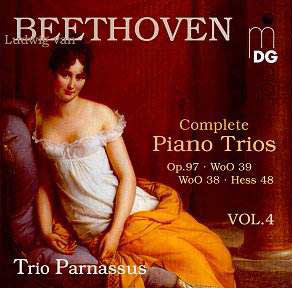This fourth volume of MDG’s series brings together
the alpha and omega of Beethoven’s music for piano trio – the longest
and the shortest, the latest and the earliest, the best known and the
least known, the greatest and the slightest. You may prefer to have
your ‘Archduke’ coupled (more conventionally) with another ‘Ghost’,
perhaps, or (more enterprisingly) with its mighty Op 70 counterpart,
the E flat, Op 70/2. But this programme affords a fascinating insight
into the composer’s stylistic development, and the length and breadth
of his genius.
Forgive me if I break with convention and make mention
at the outset of MDG’s outstandingly truthful recording, which is exemplary
in its presence, clarity, range and spaciousness. Although the microphones
are obviously fairly close to the players – we can easily ‘place’ individual
musicians; indeed we can almost feel them – the lovely acoustic
provides ample depth and ‘distance’. And the piano (it must be said)
is beautifully voiced: its sparkling highs are matched by resonantly
weighty lows.
Trio Parnassus have nothing to fear from these levels
of hi-fidelity: they are a most musical team – a most musical
team, and a most musical team. I enjoyed their playing enormously:
in particular, the cellist’s fabulous singing tone is matched by a rich
and gorgeously full bass voice. Although my disappointments with these
performances are several in number, they are almost entirely trivial
in nature, and in large part come down to personal preference anyway.
The first movement of the ‘Archduke’ does not drag,
as so often happens, mainly because its relaxed cantabile character
is (as it ought to be) identified as one of several components, and
not the over-arching mood. The group aren’t always in agreement about
matters of detail, it seems: the pianist’s slightly mannered rubato
into his statement of the second theme, for example, is not echoed in
his colleagues’ reply. And I thought their move into the recapitulation
rather straight-faced, if not clumsy: admittedly, this isn’t one of
Beethoven’s subtlest transitions, but with good (i.e. better) management
it can be made into a melting moment.
The Scherzo is laid back but energetic – precisely
the qualities the music demands – and the slippery chromatic links are
well managed.
Fortunately (but unusually) the slow movement is not
slow, in line with every indication that Beethoven gives us. I thought
the phrases might be made to ‘breathe’ more, with more finishing at
cadence points: but perhaps Beethoven’s gentle undulations should be
left to speak for themselves? The variations are nicely characterised,
their apparently increasing tempo the better for not starting
too slow.
As for the sudden return to a slow tempo and the subsequent
meanderings as the door is gradually opened on the finale, I find these
a shade literal. This music can be playful, or it can be mysterious,
prompting the question "where on earth next…?" Again, it could
be said that Trio Parnassus don’t tell you what to think, but rather
leave everything out in the open. The comings and goings of the Rondo
itself are well captured and manipulated.
WoO39 appears immature, certainly texturally, after
Op 97, but it really does postdate the ‘Archduke’. Written for a 10-year-old
pupil, the piano part is deliberately ‘easy’, but the simple dialogue
of voices is nevertheless a joy to hear.
WoO38 is, by contrast, a very early work from his Bonn
years. There are three short movements, all them quick or quickish:
perhaps the slow movement is lost? Much of the material is charming,
and there are occasional daring modulations and unorthodox gearchanges
which tell you that a master-to-be is at the helm.
Hess 48 is nothing more than a short-lived sketch on
a dotted rhythmic idea. It comes last on the disc – no grand finale,
this! – and I wonder how often we will want to give it our full attention
after hearing the masterpiece of nearly 30 years later. I suppose the
programming facility on our CD players (I must use it more often…) allows
you to do what you want, including rearranging things into chronological
sequence. But whatever you do, you get an awful lot of (superficially-)
similar-sounding B flat and E flat major here!
Peter J Lawson


![]() See
what else is on offer
See
what else is on offer 